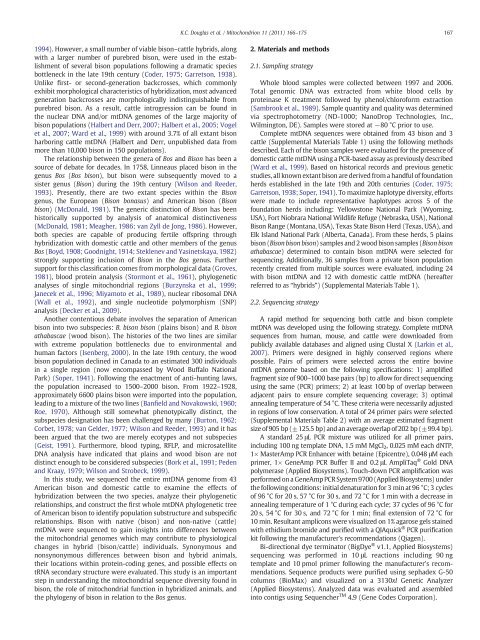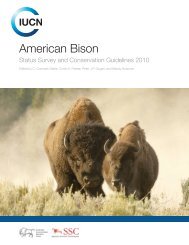Complete mitochondrial DNA sequence analysis of Bison bison and ...
Complete mitochondrial DNA sequence analysis of Bison bison and ...
Complete mitochondrial DNA sequence analysis of Bison bison and ...
Create successful ePaper yourself
Turn your PDF publications into a flip-book with our unique Google optimized e-Paper software.
1994). However, a small number <strong>of</strong> viable <strong>bison</strong>–cattle hybrids, along<br />
with a larger number <strong>of</strong> purebred <strong>bison</strong>, were used in the establishment<br />
<strong>of</strong> several <strong>bison</strong> populations following a dramatic species<br />
bottleneck in the late 19th century (Coder, 1975; Garretson, 1938).<br />
Unlike first- or second-generation backcrosses, which commonly<br />
exhibit morphological characteristics <strong>of</strong> hybridization, most advanced<br />
generation backcrosses are morphologically indistinguishable from<br />
purebred <strong>bison</strong>. As a result, cattle introgression can be found in<br />
the nuclear <strong>DNA</strong> <strong>and</strong>/or mt<strong>DNA</strong> genomes <strong>of</strong> the large majority <strong>of</strong><br />
<strong>bison</strong> populations (Halbert <strong>and</strong> Derr, 2007; Halbert et al., 2005; Vogel<br />
et al., 2007; Ward et al., 1999) with around 3.7% <strong>of</strong> all extant <strong>bison</strong><br />
harboring cattle mt<strong>DNA</strong> (Halbert <strong>and</strong> Derr, unpublished data from<br />
more than 10,000 <strong>bison</strong> in 150 populations).<br />
The relationship between the genera <strong>of</strong> Bos <strong>and</strong> <strong>Bison</strong> has been a<br />
source <strong>of</strong> debate for decades. In 1758, Linneaus placed <strong>bison</strong> in the<br />
genus Bos (Bos <strong>bison</strong>), but <strong>bison</strong> were subsequently moved to a<br />
sister genus (<strong>Bison</strong>) during the 19th century (Wilson <strong>and</strong> Reeder,<br />
1993). Presently, there are two extant species within the <strong>Bison</strong><br />
genus, the European (<strong>Bison</strong> bonasus) <strong>and</strong> American <strong>bison</strong> (<strong>Bison</strong><br />
<strong>bison</strong>) (McDonald, 1981). The generic distinction <strong>of</strong> <strong>Bison</strong> has been<br />
historically supported by <strong>analysis</strong> <strong>of</strong> anatomical distinctiveness<br />
(McDonald, 1981; Meagher, 1986; van Zyll de Jong, 1986). However,<br />
both species are capable <strong>of</strong> producing fertile <strong>of</strong>fspring through<br />
hybridization with domestic cattle <strong>and</strong> other members <strong>of</strong> the genus<br />
Bos (Boyd, 1908; Goodnight, 1914; Steklenev <strong>and</strong> Yasinetskaya, 1982)<br />
strongly supporting inclusion <strong>of</strong> <strong>Bison</strong> in the Bos genus. Further<br />
support for this classification comes from morphological data (Groves,<br />
1981), blood protein <strong>analysis</strong> (Stormont et al., 1961), phylogenetic<br />
analyses <strong>of</strong> single <strong>mitochondrial</strong> regions (Burzynska et al., 1999;<br />
Janecek et al., 1996; Miyamoto et al., 1989), nuclear ribosomal <strong>DNA</strong><br />
(Wall et al., 1992), <strong>and</strong> single nucleotide polymorphism (SNP)<br />
<strong>analysis</strong> (Decker et al., 2009).<br />
Another contentious debate involves the separation <strong>of</strong> American<br />
<strong>bison</strong> into two subspecies: B. <strong>bison</strong> <strong>bison</strong> (plains <strong>bison</strong>) <strong>and</strong> B. <strong>bison</strong><br />
athabascae (wood <strong>bison</strong>). The histories <strong>of</strong> the two lines are similar<br />
with extreme population bottlenecks due to environmental <strong>and</strong><br />
human factors (Isenberg, 2000). In the late 19th century, the wood<br />
<strong>bison</strong> population declined in Canada to an estimated 300 individuals<br />
in a single region (now encompassed by Wood Buffalo National<br />
Park) (Soper, 1941). Following the enactment <strong>of</strong> anti-hunting laws,<br />
the population increased to 1500–2000 <strong>bison</strong>. From 1922–1928,<br />
approximately 6600 plains <strong>bison</strong> were imported into the population,<br />
leading to a mixture <strong>of</strong> the two lines (Banfield <strong>and</strong> Novakowski, 1960;<br />
Roe, 1970). Although still somewhat phenotypically distinct, the<br />
subspecies designation has been challenged by many (Burton, 1962;<br />
Corbet, 1978; van Gelder, 1977; Wilson <strong>and</strong> Reeder, 1993) <strong>and</strong> it has<br />
been argued that the two are merely ecotypes <strong>and</strong> not subspecies<br />
(Geist, 1991). Furthermore, blood typing, RFLP, <strong>and</strong> microsatellite<br />
<strong>DNA</strong> <strong>analysis</strong> have indicated that plains <strong>and</strong> wood <strong>bison</strong> are not<br />
distinct enough to be considered subspecies (Bork et al., 1991; Peden<br />
<strong>and</strong> Kraay, 1979; Wilson <strong>and</strong> Strobeck, 1999).<br />
In this study, we <strong>sequence</strong>d the entire mt<strong>DNA</strong> genome from 43<br />
American <strong>bison</strong> <strong>and</strong> domestic cattle to examine the effects <strong>of</strong><br />
hybridization between the two species, analyze their phylogenetic<br />
relationships, <strong>and</strong> construct the first whole mt<strong>DNA</strong> phylogenetic tree<br />
<strong>of</strong> American <strong>bison</strong> to identify population substructure <strong>and</strong> subspecific<br />
relationships. <strong>Bison</strong> with native (<strong>bison</strong>) <strong>and</strong> non-native (cattle)<br />
mt<strong>DNA</strong> were <strong>sequence</strong>d to gain insights into differences between<br />
the <strong>mitochondrial</strong> genomes which may contribute to physiological<br />
changes in hybrid (<strong>bison</strong>/cattle) individuals. Synonymous <strong>and</strong><br />
nonsynonymous differences between <strong>bison</strong> <strong>and</strong> hybrid animals,<br />
their locations within protein-coding genes, <strong>and</strong> possible effects on<br />
tRNA secondary structure were evaluated. This study is an important<br />
step in underst<strong>and</strong>ing the <strong>mitochondrial</strong> <strong>sequence</strong> diversity found in<br />
<strong>bison</strong>, the role <strong>of</strong> <strong>mitochondrial</strong> function in hybridized animals, <strong>and</strong><br />
the phylogeny <strong>of</strong> <strong>bison</strong> in relation to the Bos genus.<br />
K.C. Douglas et al. / Mitochondrion 11 (2011) 166–175<br />
2. Materials <strong>and</strong> methods<br />
2.1. Sampling strategy<br />
Whole blood samples were collected between 1997 <strong>and</strong> 2006.<br />
Total genomic <strong>DNA</strong> was extracted from white blood cells by<br />
proteinase K treatment followed by phenol/chlor<strong>of</strong>orm extraction<br />
(Sambrook et al., 1989). Sample quantity <strong>and</strong> quality was determined<br />
via spectrophotometry (ND-1000; NanoDrop Technologies, Inc.,<br />
Wilmington, DE). Samples were stored at −80 °C prior to use.<br />
<strong>Complete</strong> mt<strong>DNA</strong> <strong>sequence</strong>s were obtained from 43 <strong>bison</strong> <strong>and</strong> 3<br />
cattle (Supplemental Materials Table 1) using the following methods<br />
described. Each <strong>of</strong> the <strong>bison</strong> samples were evaluated for the presence <strong>of</strong><br />
domestic cattle mt<strong>DNA</strong> using a PCR-based assay as previously described<br />
(Ward et al., 1999). Based on historical records <strong>and</strong> previous genetic<br />
studies, all known extant <strong>bison</strong> are derived from a h<strong>and</strong>ful <strong>of</strong> foundation<br />
herds established in the late 19th <strong>and</strong> 20th centuries (Coder, 1975;<br />
Garretson, 1938; Soper, 1941). To maximize haplotype diversity, efforts<br />
were made to include representative haplotypes across 5 <strong>of</strong> the<br />
foundation herds including: Yellowstone National Park (Wyoming,<br />
USA), Fort Niobrara National Wildlife Refuge (Nebraska, USA), National<br />
<strong>Bison</strong> Range (Montana, USA), Texas State <strong>Bison</strong> Herd (Texas, USA), <strong>and</strong><br />
Elk Isl<strong>and</strong> National Park (Alberta, Canada). From these herds, 5 plains<br />
<strong>bison</strong> (<strong>Bison</strong> <strong>bison</strong> <strong>bison</strong>) samples <strong>and</strong> 2 wood <strong>bison</strong> samples (<strong>Bison</strong> <strong>bison</strong><br />
athabascae) determined to contain <strong>bison</strong> mt<strong>DNA</strong> were selected for<br />
sequencing. Additionally, 36 samples from a private <strong>bison</strong> population<br />
recently created from multiple sources were evaluated, including 24<br />
with <strong>bison</strong> mt<strong>DNA</strong> <strong>and</strong> 12 with domestic cattle mt<strong>DNA</strong> (hereafter<br />
referred to as “hybrids”) (Supplemental Materials Table 1).<br />
2.2. Sequencing strategy<br />
A rapid method for sequencing both cattle <strong>and</strong> <strong>bison</strong> complete<br />
mt<strong>DNA</strong> was developed using the following strategy. <strong>Complete</strong> mt<strong>DNA</strong><br />
<strong>sequence</strong>s from human, mouse, <strong>and</strong> cattle were downloaded from<br />
publicly available databases <strong>and</strong> aligned using Clustal X (Larkin et al.,<br />
2007). Primers were designed in highly conserved regions where<br />
possible. Pairs <strong>of</strong> primers were selected across the entire bovine<br />
mt<strong>DNA</strong> genome based on the following specifications: 1) amplified<br />
fragment size <strong>of</strong> 900–1000 base pairs (bp) to allow for direct sequencing<br />
using the same (PCR) primers; 2) at least 100 bp <strong>of</strong> overlap between<br />
adjacent pairs to ensure complete sequencing coverage; 3) optimal<br />
annealing temperature <strong>of</strong> 54 °C. These criteria were necessarily adjusted<br />
in regions <strong>of</strong> low conservation. A total <strong>of</strong> 24 primer pairs were selected<br />
(Supplemental Materials Table 2) with an average estimated fragment<br />
size <strong>of</strong> 905 bp (±125.5 bp) <strong>and</strong> an average overlap <strong>of</strong> 202 bp (±99.4 bp).<br />
A st<strong>and</strong>ard 25 μL PCR mixture was utilized for all primer pairs,<br />
including 100 ng template <strong>DNA</strong>, 1.5 mM MgCl2, 0.025 mM each dNTP,<br />
1× MasterAmp PCR Enhancer with betaine (Epicentre), 0.048 μM each<br />
primer, 1× GeneAmp PCR Buffer II <strong>and</strong> 0.2 μL AmpliTaq ® Gold <strong>DNA</strong><br />
polymerase (Applied Biosystems). Touch-down PCR amplification was<br />
performed on a GeneAmp PCR System 9700 (Applied Biosystems) under<br />
the following conditions: initial denaturation for 3 min at 96 °C; 3 cycles<br />
<strong>of</strong> 96 °C for 20 s, 57 °C for 30 s, <strong>and</strong> 72 °C for 1 min with a decrease in<br />
annealing temperature <strong>of</strong> 1 °C during each cycle; 37 cycles <strong>of</strong> 96 °C for<br />
20 s, 54 °C for 30 s, <strong>and</strong> 72 °C for 1 min; final extension <strong>of</strong> 72 °C for<br />
10 min. Resultant amplicons were visualized on 1% agarose gels stained<br />
with ethidium bromide <strong>and</strong> purified with a QIAquick ® PCR purification<br />
kit following the manufacturer's recommendations (Qiagen).<br />
Bi-directional dye terminator (BigDye ® v1.1, Applied Biosystems)<br />
sequencing was performed in 10 μL reactions including 90 ng<br />
template <strong>and</strong> 10 pmol primer following the manufacturer's recommendations.<br />
Sequence products were purified using sephadex G-50<br />
columns (BioMax) <strong>and</strong> visualized on a 3130xl Genetic Analyzer<br />
(Applied Biosystems). Analyzed data was evaluated <strong>and</strong> assembled<br />
into contigs using Sequencher TM 4.9 (Gene Codes Corporation).<br />
167










